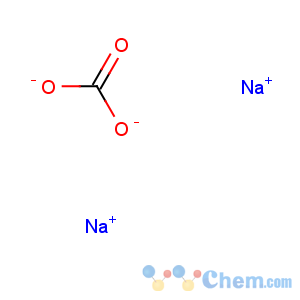Title: Sodium Carbonate
CAS Registry Number: 497-19-8
Molecular Formula: CNa2O3
Molecular Weight: 105.99
Percent Composition: C 11.33%, Na 43.38%, O 45.29%
Line Formula: Na2CO3
Literature References: Occurs in nature as the hydrate,
thermonatrite, and the decahydrate,
natron or
natrite. Produced by the ammonia-soda or Solvay process, or from lake brines or sea water by electrolytic processes:
Faith, Keyes & Clark's Industrial Chemicals, F. A. Lowenheim, M. K. Moran, Eds. (Wiley-Interscience, New York, 4th ed., 1975) pp 706-715. Toxicity: C. Norde
et al., Compt. Rend. 257, 791 (1963).
Reviews: Bailey in
Mellor's vol II, suppl II,
The Alkali Metals (part 1), 1058-1205 (1961).
Derivative Type: Anhydrous
Synonyms: Solvay soda
Properties: The technical grade (about 99% pure) is known as
soda ash. Odorless, hygroscopic powder; alkaline taste; d 2.53. mp 851° but begins to lose CO2 even at 400°. On exposure to air it will gradually absorb one mol water, about 15%. Sol in glycerol; in 3.5 parts water at room temp, 2.2 parts water at 35°. Insol in alcohol. Dec by acids with effervescence. Combines with water with evolution of heat. Its aq soln is strongly alkaline. pH 11.6.
Keep well closed. LD50 (30 day) i.p. in mice: 116.6 mg/kg (Norde).
Melting point: mp 851°
Density: d 2.53
Toxicity data: LD50 (30 day) i.p. in mice: 116.6 mg/kg (Norde)
Derivative Type: Monohydrate
Properties: Odorless, small crystals or cryst powder; alkaline taste. Stable at ordinary temps and atmospheric conditions; dries out somewhat in warm, dry air or above 50°; becomes anhydr at 100°. d 2.25; also reported as 1.55. Sol in 3 parts water, 1.8 parts boiling water, 7 parts glycerol. Insol in alcohol.
Density: d 2.25; also reported as 1.55
Derivative Type: Decahydrate
Synonyms: Nevite; Soda
Properties: The technical product is known as
sal soda or
washing soda. Transparent crystals; readily effloresces on exposure to air. d 1.46. mp 34°. Sol in 2 parts cold, 0.25 part boiling water, in glycerol. Insol in alcohol. The aq soln is strongly alkaline to litmus.
Keep well closed and in a cool place.
Melting point: mp 34°
Density: d 1.46
CAUTION: Potential symptoms of overexposure to dusts or vapors of sodium carbonate are irritation of mucous membranes with subsequent coughing and shortness of breath. Chronic overexposure may lead to perforation of the nasal septum. Direct contact may cause skin irritation and redness, with concentrated solutions causing erythema. Chronic skin exposures may cause dermatitis and ulceration.
See Patty's Industrial Hygiene and Toxicology vol. 2A, G. D. Clayton, F. E. Clayton, Eds. (Wiley-Interscience, New York, 4th ed., 1993) pp 769-771.
Use: In manuf of Na salts, glass, soap; for washing wool; textiles, etc.; in bleaching linen, cotton; general cleanser; in water-softening; in photography; as reagent in analytical chemistry. Pharmaceutic aid (alkalizer).
Therap-Cat-Vet: Has been used as an emetic. In solution to cleanse skin, in eczema, to soften scabs of ringworm.

